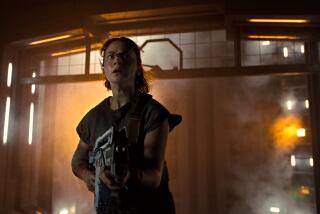The Super Natural
CONSHOCKEN, Pa. — The distance between the administrative offices of Burning Edge Pictures and the actual production “annex”--for want of a better word--seems narrow enough to be covered as quickly by foot as by wheel. But given all the tricky curves and jumps along the way, it’s better that we’re getting a lift this morning from Burning Edge’s head honcho, who’s happy to oblige despite the fact that his outfit’s about to enter what he terms the “red zone” of its latest enterprise.
“Red zone,” for those with better things to do with their autumn weekends, is football jargon for the area between the 20-yard line and the end zone. M. Night Shyamalan, who grew up and still lives and works in this suburban Philadelphia community, may be more susceptible than most filmmakers to such metaphors as “red zone,” given the City of Brotherly Love’s fervent, if often ungratified, passion for sports.
The analogy is nonetheless appropriate, given that there is in Shyamalan’s manner this morning the blithe assurance and keyed-up intensity one imagines in a quarterback mentally surveying his options for scoring with less than two minutes to play in a championship game.
For it is the morning after the second and final test-audience screening of Shyamalan’s forthcoming movie, “Unbreakable,” before its Nov. 22 premiere. This is the first film written and directed by the 30-year-old Shyamalan since his previous supernatural thriller, the $38-million “The Sixth Sense,” shocked the world by making $293.5 million at the box office and garnering six Academy Award nominations.
Bruce Willis, who played the lead role of a guilt-ridden child psychologist in “The Sixth Sense,” returns in “Unbreakable,” co-starring Samuel L. Jackson. Disney’s Touchstone Pictures is banking on Shyamalan’s fourth feature film to perform well on that crucial Thanksgiving weekend. So, with the remaining time being measured in weeks and days, the clock is ticking. Yet Shyamalan is feeling no discernible pressure. In fact, he’s buoyant over the previous night’s reaction from his test audience (a positive response buttressed from a rave materializing that day on the Ain’t-It-Cool-News Web site from one of the attendees). As he arrives at the annex for a full day of editing, Shyamalan (pronounced “shy-uh-MELL-in”) is so jaunty that he tells his visitor a story about the highway overpass looming over the parking lot.
“There was a guy who tried to kill himself jumping off from way up high,” Shyamalan says, pointing at the peak of the overpass. “Couldn’t even do that right. He landed in the ravine down there, which had even less water than it has now. He lived.”
Shyamalan relates this tale with enough of a glint in his wide espresso eyes to suggest that he’s pulling his visitor’s leg a tad. One can, in fact, be forgiven for thinking there’s some calculation in leaking what could be little more than one of those urban legends since it’s not too far from the story line of “Unbreakable,” which is almost as creepily alluring as that of “The Sixth Sense.” In “Unbreakable,” Willis plays a stadium security guard who inexplicably walks away from calamitous train and car wrecks without a scratch. Jackson is his polar opposite, a man born with brittle, easily shattered bones, who seeks Willis out for some explanation for their physical conditions.
*
Shyamalan says he got the idea while nursing a broken leg he suffered in a pickup basketball game. Other factors were in play as well. “Because I’m a little phobic about flying in planes, I would fantasize about what it would be like to totally survive a crash. [The idea] wasn’t the first thing that came to my head after ‘Sixth Sense’ since I was already actually writing an outline for a different script before all these factors came together in this other idea for what became ‘Unbreakable.’ I talked it over with my wife. She said it sounded interesting. It just started to grow on its own.”
Those looking for more plot detail than this about “Unbreakable” will get little help from this article. Shyamalan is so edgy about shielding the movie’s secrets from his visitor that both he and his editor, Dylan Tichenor (“Magnolia,” “Hurlyburly”), spend most of the day reviewing the test screening’s reactions and talking around many of the crucial plot points. (“Not that we don’t trust you,” Tichenor unconvincingly assures us.) So the few clips that get worked over during this session are scrupulously unrevealing: Willis poking around a closet for a gun, Willis sneaking around a vacant lot on a rainy night and Willis aboard a passenger train that collides violently with another. “We want,” Shyamalan says with a grin, “to keep you as virginal as possible.”
*
After all, it was the surprise twist at the climax of “The Sixth Sense” that was considered integral to the movie’s phenomenal success. Everyone expects the end of “Unbreakable” to provide a similar jolt, though only relatively few know what it is and none seems willing to spoil everyone’s fun. Even the Ain’t-It-Cool-News guy is keeping his mouth shut. But do trick endings explain everything about “The Sixth Sense’s” multimillion-dollar box office--and, for that matter, its millions more in video sales and rental fees? Official records aren’t kept of those who see the same movie more than once. But as “The Sixth Sense,” which opened in August 1999, stayed at or near the top spot on the box-office scorecard well past that Labor Day, part of the movie’s prodigious word-of-mouth centered on those who were paying to see the movie a third, fourth or fifth time.
“Yeah, it’s something I wondered about too,” Shyamalan says. “And I think there were multiple reasons. One, because they got something new each time and wanted to see it again to see if there was anything else to cull. Or, maybe, there were those who said, like, ‘Hey, I’m bringing my sister or cousin this time.’ And they’d say to them, ‘OK, I know you’re scared of horror movies, but just sit and watch.’ And at the end, it’s like, ‘Omigod!’ And, ‘See, I told you!’ And you could count on that audience coming back at least twice too.”
Then too there were aspects of the movie’s appeal that had less to do with entertainment value than with the more spiritual ramifications of Willis’ 10-year-old client, played by Oscar-nominee Haley Joel Osment, being able to “see dead people.”
“I think there was a fundamental question [being addressed] that people have,” Shyamalan says. “You know, what happens when you die? Or my loved one dies? Is that it? And just offering the possibility that it’s not it, that it’s going to be OK, it’s very comforting to people. And I still get stopped by people who tell me that they’ve seen dead people too. I don’t always know what to say to that.” He grins.
To the extent he can talk about “Unbreakable” at all, Shyamalan admits that if there’s any thematic hinge connecting the new movie to the previous one, it is the matter of “faith. Believing that once you bring your mind to a place of believing, things open up for you that you can’t possibly imagine.”
Shyamalan’s own strong-willed faith in such matters was forged by his education, both in and out of movie theaters. Born in India to two physicians, Shyamalan (whose first name is Manoj, but who’s OK with his friends calling him “Night,” which he later adopted) attended Episcopal Academy in Lower Merion, Pa. “I was put there because my parents thought I needed discipline and regimentation,” he recalls. “I guess it had an effect on me in the sense that I really need routine, control and discipline in my personal and professional life.”
Shyamalan says just about everyone in his immediate family was a Type-A achiever, many of them doctors, lawyers, bankers and technicians. He was more of a dreamer, having been, like many in his generation, influenced at an impressionable age by George Lucas’ “Star Wars” trilogy and, especially, the films of Steven Spielberg. The religious instruction Shyamalan received at school turned out to be harmonious with the visceral charge he received from those mid-1970s and early-1980s blockbusters.
“The older I get, the more I realize that whenever I came across a story about believing in something other than what you see, I was, like, immediately in there, 100%. When I was 7 or 8 and saw ‘Star Wars’ and all that stuff about the Force, it struck me as, well, yeah, that’s possible. Same with ‘E.T.’ I was 12 when I saw it and it meant so much to me at the time because there was so much about faith in the way that kid believed in the extraterrestrial.”
He was duly inspired to pick up a Super-8 camera at age 8 and make his own movies. By 17, he had made more than 40 short films and written a handful of full-length scripts. The achiever genes had by then kicked in with a vengeance. Immediately after graduating from NYU Film School in 1991, Shyamalan went to India with about $750,000 to produce and direct one of his scripts, “Praying With Anger,” about an Indian American youth grasping for maturity and experience in his parents’ homeland.
Although that feature wasn’t widely distributed, it was impressive enough as a calling card for Shyamalan to secure a deal with Miramax to make “Wide Awake,” a 1998 comedy-drama about a parochial schoolboy grieving for his dead grandfather and struggling for understanding as bewildered friends, teachers and family members watch on the sidelines.
*
Despite a cast that included Robert Loggia, Dana Delany and Rosie O’Donnell, “Wide Awake” was a critical and box-office fiasco (though it’s not quite as bad as its reputation). Shyamalan, who says he fought constantly with Miramax executives over almost every aspect of the movie, regards “Wide Awake” as a cautionary experience: something he had to “get through” to learn how to tell a story better, and how to secure and maintain autonomy over his projects.
When Shyamalan’s story of a crime photographer-cum-serial killer mutated into “The Sixth Sense’s” tale of a dead man walking (so to speak), Disney gave him the green light and a modest $1 million for the script. Things changed after last summer. For the “Unbreakable” screenplay, Shyamalan received $5 million.
Though his price has gone up, Shyamalan has no intention of shifting his home base to New York or Los Angeles. To be closer to the action, in Shyamalan’s view, would risk upsetting the harmony and focus he needs to work at his best. So when he talks about getting a new home for his wife, Bhavna Vaswani, and their two daughters, ages 4 and 11 months, it’s in terms of a bigger house in the same area.
“Obviously, life has changed in so many ways since ‘Sixth Sense,’ ” he says. “But I feel safe and normal here. I remember the day after ‘Sixth Sense’ was nominated for all those Oscars; I was trying to put the garbage out in front of our driveway. And the dog next door was trying to take the garbage from me and the driveway became a mess and I went to the neighbors to complain and I felt great! This was the leveling experience I needed at that moment. Because if I lived in L.A. or in that kind of environment, I wouldn’t have moments like the dog and the garbage in my life that I could, maybe, put away for future use. It wouldn’t be real. Even though I make movies about strange things, I always want real people in them.”
More to Read
Only good movies
Get the Indie Focus newsletter, Mark Olsen's weekly guide to the world of cinema.
You may occasionally receive promotional content from the Los Angeles Times.










